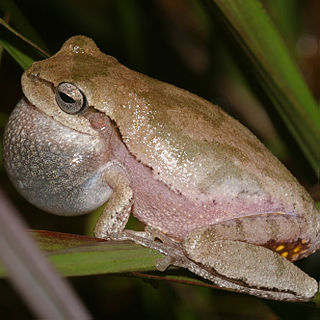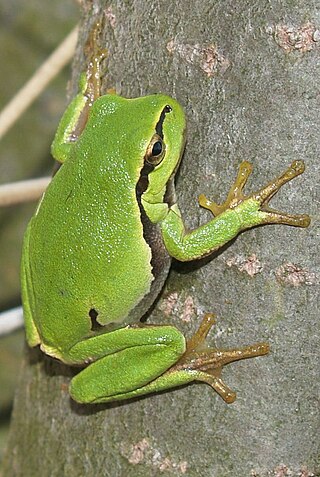
Hylidae is a wide-ranging family of frogs commonly referred to as "tree frogs and their allies". However, the hylids include a diversity of frog species, many of which do not live in trees, but are terrestrial or semiaquatic.

The canebrake tree frogs are a frog genus Aplastodiscus. They are in the family Hylidae. Residing primarily in southeast regions of Brazil near the Atlantic coast. The exception is the Aplastodiscus perviridis which is found mostly in Brazil, but has also been documented being in Argentina, and might reside in Paraguay. The major revision of the Hylidae genus expanded it to include 12 more species originally from Hyla. Before the revision there were only 2 species. There are currently 16 described species with the most recent addition Aplastodiscus heterophonicus being described in 2021.

Charadrahyla is a genus of frogs in the family Hylidae. It is endemic to tropical southern Mexico. The generic name was derived from Greek charadra ("ravine") and Hyla, in reference to the habits of these frogs. Accordingly, common name ravine treefrogs has been coined for the genus.
Calamita melanorabdotus is a possible species of frog reported from Brazil in 1799. A 19th century treatise considered it to be a junior synonym of Hyla lactea, but it is now considered a nomen dubium.
"Calamita" quadrilineatus is a possible species of frog described in 1799. The type locality is unknown, but the original publication considered Calamita quadrilineatus to be similar to Hyla leucophyllata. The status of this name placed in the subfamily Hylinae is unclear and it is considered a nomen dubium. The type series is presumed to be lost.
The porthole tree frog is a species of frog in the family Hylidae endemic to Mexico. Its natural habitats are subtropical or tropical moist montane forests and rivers. It is threatened by habitat loss.

Dendropsophus bogerti is a species of frog in the family Hylidae. It is endemic to the Andes of Colombia and occurs in the Cordillera Central in Antioquia, Caldas, and Chocó Departments. The specific name bogerti honors Charles Mitchill Bogert, an American herpetologist. Soon after its description in 1970, it was relegated to synonymy of Dendropsophus carnifex, but its species status was restored in 1997.
Dendropsophus meridianus is a species of frog in the family Hylidae. It is endemic to southeastern Brazil.
Charadrahyla pinorum is a species of frog in the family Hylidae. It is endemic to the Pacific slopes of Sierra Madre del Sur between central Guerrero and southwestern and central Oaxaca, Mexico. Common names pine wood treefrog and Mexican pine woods treefrog have been proposed for it. Its closest relative is probably Charadrahyla juanitae.
Hyla auraria is a scientific name used by Wilhelm Peters to describe a species of frog in 1873 based on material that presumably originated from South America. The status of this name placed in the subfamily Hylinae is unclear. The holotype still exists and is in good condition but faded, and it has not been possible to relate it to known species or genera of frogs. Consequently, Hyla auraria is considered a nomen dubium.

The common Chinese tree frog, also known under common names common Chinese treetoad and Chinese tree toad, is a species of frog in the family Hylidae found in southeastern and eastern China and in Taiwan. There is also one record from Vietnam but it is uncertain whether it really represents this species or Hyla annectans.

The pine woods tree frog is a species of frog in the family Hylidae, endemic to the southeastern United States.

Annam tree frog, also known as the South China tree toad, is a species of frog in the family Hylidae. It is found in southern China, Vietnam, and Laos. The Hainan tree toad from Hainan Island is treated as a subspecies.
The cloud forest tree frog is a species of frog in the family Hylidae endemic to Mexico. Its natural habitats are subtropical or tropical moist montane forests and rivers. It is threatened by habitat loss.
Sarcohyla cembra, also known as the Southern Sierra Madre treefrog, is a species of frog in the family Hylidae. It is endemic to Mexico. Until recently, it was only known from two male specimens: one from its type locality on the Pacific slopes of the Sierra Madre del Sur mountains, Pochutla District, Oaxaca, and another one from Sierra de Yucuyacua south-east of Llano de Guadalupe, in north-west Oaxaca. The two locations are about 172 km (107 mi) apart. After having not been seen after 1993, it was feared that the species might be extinct. However, the species was rediscovered in field surveys in 2011–2012, extending its range with a new locality about 10 km north of the type locality.
"Hyla" nicefori also known as the Colombian backpack frog, is a species of frog in the family Hylidae. It is endemic to the border region between Boyacá and Casanare in Colombia and only known from the holotype. The name format, as used by the American Museum of Natural History's Amphibian Species of the World, indicates that while this species is temporarily kept in the hylid type genus Hyla, it belongs elsewhere in the family and will be reassigned pending a taxonomic resolution. It was originally placed in Cryptobatrachus, but a later study revealed a number morphological differences showing that it is not in family Hemiphractidae, instead pointing to it being a hylid frog, perhaps Hyloscirtus.

Hylinae is a large subfamily of "tree frogs", family Hylidae.

Rheohyla is a genus of frogs in the family Hylidae. As currently recognized, it is monotypic, containing only Rheohyla miotympanum, also known as the small-eared hyla or small-eared treefrog. However, the nominal species likely is a complex of more than one species. It is endemic to eastern and central Mexico. The generic name refers to streams, the breeding habitat of this frog. The specific name is derived from Greek meion, a diminutive prefix, together with Greek tympanon (='drum') and refers to the small tympanum.








